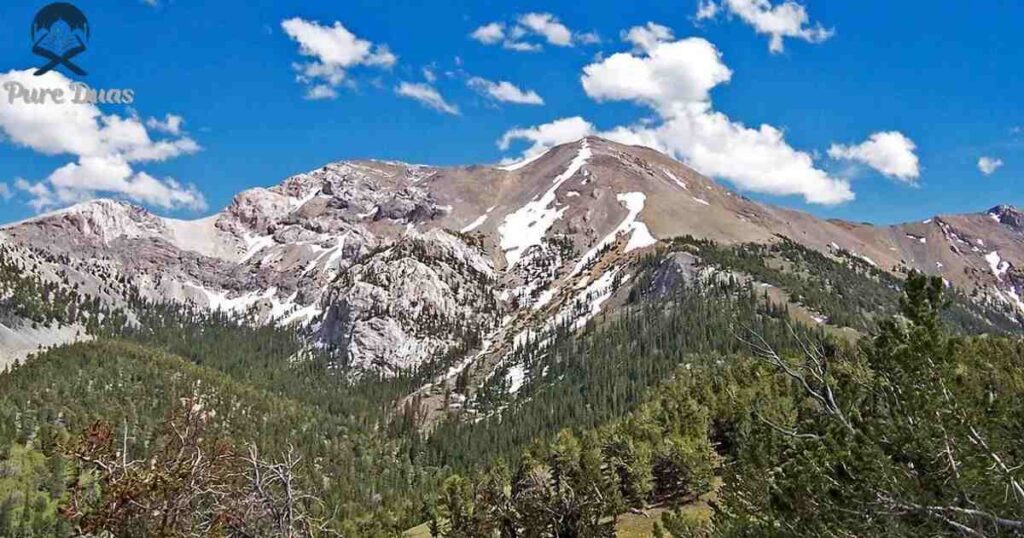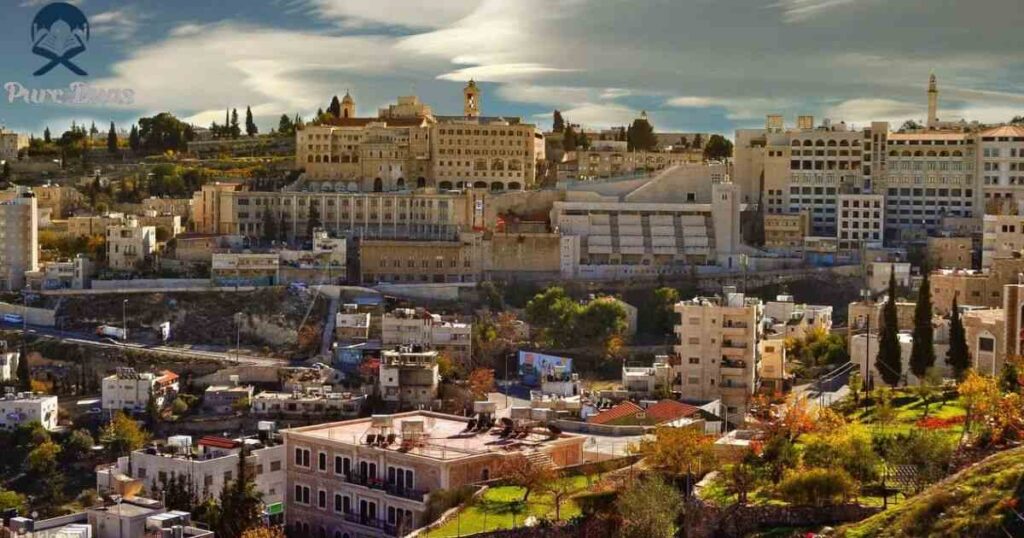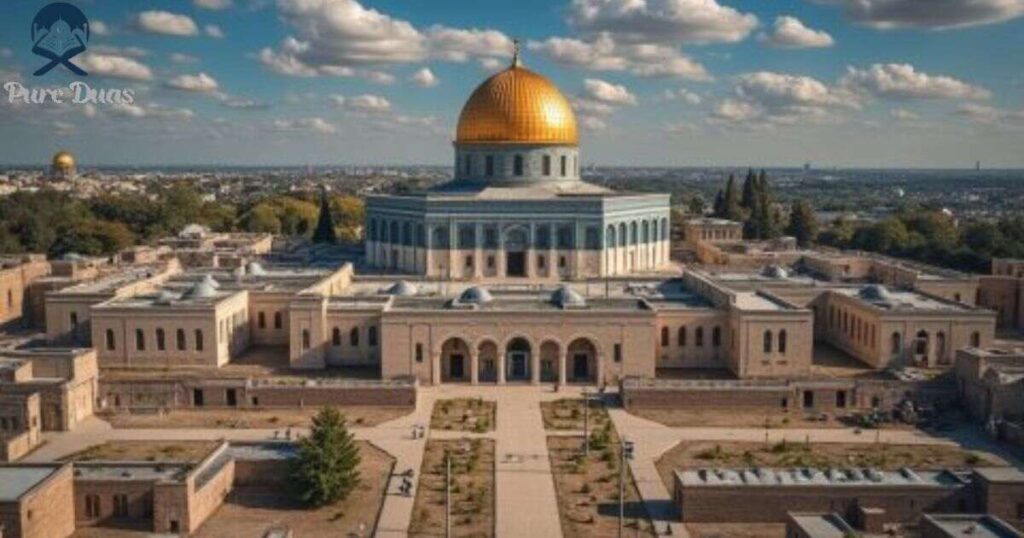The Bible is not just a collection of spiritual teachings, it is a journey through real places where God met humanity. These locations are not merely dots on ancient maps. They’re where miracles happened, covenants were made, and history turned on its axis. From Eden’s perfect garden to the glittering New Jerusalem, each site tells part of God’s grand story. You will discover how geography shaped faith and how divine intervention transformed ordinary ground into holy territory.
These important places in the Bible reveal patterns of judgment, mercy, and redemption that still speak today. Whether you are studying Scripture or planning a pilgrimage, understanding these locations deepens your connection to God’s Word. Let us explore twenty-five sites that forever altered the course of human destiny and divine purpose.
Why Biblical Locations Hold Deep Spiritual Significance
Geography matters in Scripture. God did not choose random spots for pivotal moments.
Mountains brought people closer to heaven. Rivers symbolized cleansing and transition. Cities represented human achievement, and sometimes pride.
When Jesus taught on hillsides, crowds could hear better. When Moses climbed Sinai, the ascent itself built anticipation. Physical spaces created spiritual experiences.
These biblical locations also carry prophetic weight. Jerusalem appears in both Genesis and Revelation. The pattern reveals intentional design.
God uses places to teach lessons. A garden showed paradise. A wilderness tested faith. A cross demonstrated sacrifice.
Garden of Eden

The Paradise Where Creation Began
Eden was humanity’s first home. Genesis 2:8-14 describes a lush garden with four rivers flowing from it. God planted it specifically for Adam and Eve.
Perfect harmony existed there initially. No death, disease, or discord.
Then came the serpent’s lie. Eve ate forbidden fruit. Adam followed. Sin entered through one choice, and paradise was lost forever.
Eden represents what was, and what will be again. Revelation promises a restored paradise where the tree of life grows once more.
Eden teaches us that disobedience has consequences. But it also shows God’s original intention: intimate fellowship with His people in a perfect place.
Mount Ararat
Where Noah’s Ark Found Rest After the Flood
After divine judgment destroyed the ancient world, Noah’s ark settled on Ararat’s peaks (Genesis 8:4). This mountain in modern-day Turkey became humanity’s fresh start.
The flood demonstrated God’s holiness. He won’t tolerate wickedness indefinitely. Yet mercy emerged from those same waters, eight people survived.
When Noah stepped onto dry ground, he built an altar. Worship was his first response. God then established a covenant, promising never to flood Earth again.
The rainbow became the sign. Every colorful arc reminds us that judgment and grace coexist in God’s character.
Ararat symbolizes new beginnings. Just as Noah left the ark to repopulate Earth, believers emerge from baptism’s waters to walk in the newness of life.
Tower of Babel
The Birthplace of Languages and Human Pride
Babel was about rebellion. Genesis 11:1-9 reveals humanity’s attempt to build a tower reaching heaven.
They wanted fame. “Let us make a name for ourselves,” they declared. God was not invited to their achievement party.
So he confused their language. Workers could not communicate. The project collapsed. People scattered across continents, speaking different tongues.
When humans try building kingdoms without God, confusion follows. Unity apart from Him produces chaos, not progress.
Interestingly, Pentecost reversed Babel’s curse. The Holy Spirit enabled believers to speak various languages, reuniting humanity under Christ’s banner.
Ur of the Chaldeans
Abraham’s Homeland and the Call to Faith
Abraham came from Ur, a sophisticated Mesopotamian city (Genesis 11:31). Archaeological digs reveal advanced civilization there.
God called Abraham to leave everything familiar. No GPS. No map. Just trust that God would show him the destination.
This departure marked faith’s beginning. Abraham obeyed without knowing where he’d end up. His willingness to leave comfort for promise changed history.
Ur represents what we must abandon to follow God. Sometimes He asks us to walk away from security, family, or familiar territory.
God’s promises often require leaving what is comfortable. Abraham’s obedience made him the father of faith, and father of many nations.
Canaan
The Promised Land God Gave to Israel
Canaan was God’s guarantee (Genesis 12:5). He promised this land to Abraham’s descendants forever.
The territory stretched from Lebanon to Egypt’s border. Milk and honey flowed there, symbolizing abundance beyond imagination.
But possession took time. Abraham never owned more than a burial plot. Isaac and Jacob wandered as strangers. Centuries passed before Israelites actually conquered Canaan.
Joshua finally led them across the Jordan. City by city, they claimed their inheritance.
Canaan teaches perseverance. God’s promises are certain, but timing belongs to Him. What He pledges, He delivers, though rarely on our schedule.
Sodom and Gomorrah
Cities Destroyed as Warning Against Wickedness
These twin cities embodied corruption (Genesis 19:24-25). Their sin was so great that God decided destruction was the only remedy.
Abraham negotiated with God. Would He spare the cities for fifty righteous people? Forty? Ten? God agreed to Abraham’s terms.
But not even ten righteous residents existed. Lot’s family barely escaped as fire and sulfur rained from heaven. Lot’s wife looked back longingly, and became a salt pillar.
Archaeological evidence suggests catastrophic destruction in the Dead Sea region. Sulfur balls and ash layers match biblical descriptions.
These cities warn against moral decay. God’s patience has limits. When societies embrace evil completely, judgment becomes inevitable.
Mount Moriah

Where Abraham’s Faith Was Tested
God’s command seemed impossible: “Take your son, your only son Isaac, whom you love, and sacrifice him” (Genesis 22:2).
Abraham obeyed. He built an altar on Mount Moriah. Bound Isaac. Raised the knife. Then God intervened, providing a ram instead.
Abraham learned that God provides. The place was named “The LORD Will Provide.”
Centuries later, Solomon built the Temple on this exact mountain. Where Abraham offered Isaac, God would offer His Son.
Mount Moriah foreshadowed the cross. Just as God provided a substitute ram, He provided Jesus as humanity’s substitute.
Goshen
Israel’s Egyptian Home Before the Exodus
When famine struck Canaan, Jacob’s family moved to Goshen (Genesis 45:10). This fertile Egyptian region became their home for four centuries.
Initially, they prospered. Joseph’s influence protected them. They multiplied rapidly despite living in a foreign land.
Then came oppression. A new Pharaoh enslaved them. Brick quotas increased. Baby boys were murdered. Goshen transformed from refuge to prison.
Yet God was preparing deliverance. Moses would lead them out.
Sometimes God places us in difficult situations to prepare us for greater purposes. Israel’s slavery made them desperate for freedom, and ready to follow God anywhere.
Red Sea
The Miraculous Crossing That Defined Deliverance
Pharaoh’s army pursued Israel to the Red Sea (Exodus 14:21-22). The Israelites faced water ahead and death behind.
Moses stretched his staff. Waters parted. Walls of liquid stood on both sides as two million people crossed on dry ground.
When Egyptians followed, the walls collapsed. Pharaoh’s elite force drowned. Israel was finally free.
This miracle became Israel’s defining moment. Every generation retold it. The Passover celebration commemorated it. Prophets referenced it constantly.
The Red Sea crossing symbolises salvation. Just as Israel passed through water from slavery to freedom, believers pass through baptism from death to life.
Mount Sinai
Where Moses Received the Ten Commandments
Thunder crashed. Lightning blazed. Mount Sinai smoked like a furnace as God descended (Exodus 19:20).
Moses climbed into the cloud. There, God gave him stone tablets containing the Ten Commandments, the foundation of Israel’s covenant relationship.
These were non-negotiable standards reflecting God’s character. Honor God alone. Don’t murder. Don’t steal. Don’t covet.
The mountain trembled so violently that people begged Moses to speak to God on their behalf. Direct encounters with holiness terrified them.
Mount Sinai established God’s law. It showed that a relationship with Him requires obedience. The covenant made at Sinai defined Israel as God’s chosen people.
Jericho
The First Conquest in the Promised Land
Jericho stood as Canaan’s gateway. Massive walls surrounded it. Military strategists would call it impregnable.
God’s battle plan: march around the city for six days. On day seven, march seven times, shout, and blow trumpets (Joshua 6:1-20).
Joshua obeyed precisely. On the seventh circuit, walls collapsed. Israelites rushed in and claimed their first Canaanite victory.
Rahab the prostitute survived because she’d hidden Israelite spies. Her faith saved her family. She even appears in Jesus’ genealogy, proof that God welcomes all who trust Him.
Jericho demonstrates that obedience matters more than strategy. God’s ways don’t always make sense. But when we follow His instructions exactly, victory follows.
Jordan River
Sacred Waters of Crossing and Baptism
The Jordan River witnessed two crucial crossings. First, Israel entered Canaan when God stopped the river’s flow (Joshua 3:14-17). Priests carrying the Ark of the Covenant stood in the riverbed while everyone passed.
Centuries later, Jesus waded into the same waters. John baptized Him there (Matthew 3:13-17). Heaven opened. The Spirit descended like a dove. God’s voice declared, “This is my beloved Son.”
The Jordan symbolizes transition, from wilderness to promise, from old life to new.
Pilgrims still visit today, seeking connection to these sacred moments.
Shechem
Site of Covenant Renewal and Joseph’s Rest
Shechem appears throughout Scripture. Abraham built an altar there. Jacob purchased land. Joshua gathered Israel for covenant renewal (Joshua 24:1-25).
At Shechem, Joshua challenged people: “Choose this day whom you will serve.” The nation recommitted to following God alone.
Joseph’s bones, carried from Egypt, were buried there (Joshua 24:32). His final resting place fulfilled his dying request.
Shechem represents choice and commitment. It was where Israel repeatedly decided to serve God wholeheartedly.
Shiloh
Israel’s First Religious Center
Before Jerusalem became capital, Shiloh served as Israel’s spiritual hub (Joshua 18:1). The Tabernacle stood there for over three centuries.
Hannah prayed desperately at Shiloh for a son. God granted Samuel, who grew up serving at the Tabernacle under Eli the priest.
But Shiloh’s glory ended tragically. Philistines captured the Ark of the Covenant there. The city was eventually destroyed, becoming a warning about presuming God’s presence.
Religious tradition doesn’t guarantee God’s favor. Location matters less than heart condition.
Bethlehem

Birthplace of Kings—David and Jesus
Tiny Bethlehem produced a giant impact. King David was anointed there as a shepherd boy (1 Samuel 16:1). Samuel poured oil on David’s head, marking him as Israel’s future king.
A thousand years later, another king was born there. Jesus Christ entered the world in Bethlehem’s humble stable (Luke 2:4-7). Angels announced His birth to shepherds watching nearby flocks.
Micah prophesied this centuries earlier: “But you, Bethlehem… from you shall come forth for me one who is to be ruler in Israel” (Micah 5:2).
Bethlehem means “house of bread.” How fitting that Jesus, the Bread of Life, was born there.
Mount Carmel
Where Elijah Proved God’s Power
Drought plagued Israel for three years. King Ahab had led the nation into Baal worship. Prophet Elijah challenged 450 false prophets to a showdown on Mount Carmel (1 Kings 18:19-40).
The rules: each side would prepare a sacrifice. Whichever god sent fire from heaven was the true God.
Baal’s prophets danced, shouted, and cut themselves. Nothing happened. Then Elijah drenched his altar with water, twelve jars full.
He prayed once. Fire fell from heaven, consuming sacrifice, wood, stones, soil, and water. The people fell on their faces: “The LORD, he is God!”
Mount Carmel proved God’s supremacy. False gods are powerless. Only the true God answers prayer and demonstrates His reality.
Nineveh
The Wicked City That Repented
Nineveh was Assyria’s brutal capital. Its cruelty was legendary throughout the ancient Near East.
God told Jonah to preach repentance there. Jonah refused and fled instead, he wanted judgment, not mercy for Israel’s enemies.
After three days in a fish’s belly, Jonah obeyed. He proclaimed Nineveh’s destruction in forty days. Shockingly, the entire city, from king to commoner, repented. God relented from sending disaster.
This infuriated Jonah. He’d rather see enemies destroyed than forgiven.
Nineveh demonstrates God’s compassion extends beyond chosen people. He desires repentance from all nations.
Babylon
Empire of Exile and Prophetic Judgment
Babylon conquered Jerusalem and destroyed Solomon’s Temple (2 Kings 25:1-12). The cream of Judah’s population was dragged into exile, seventy years of captivity.
Yet God used Babylon for purposes beyond punishment. Daniel’s faithfulness in exile influenced pagan kings. Nebuchadnezzar eventually acknowledged God’s supremacy.
The exile ended when Persia conquered Babylon. Cyrus allowed Jews to return home and rebuild their Temple.
Prophetically, Babylon symbolizes worldly systems opposed to God. Revelation depicts “Babylon the Great” as the ultimate embodiment of human pride that God will judge.
God uses even enemy nations to accomplish His purposes. What seems like defeat often prepares us for greater victory.
Jerusalem
The Holy City at the Heart of Biblical History
Jerusalem, the holy city, pulses through Scripture from start to finish. David conquered it. Solomon built the Temple there. Prophets preached in its streets.
Jesus taught in Jerusalem’s courts. He was arrested, tried, and crucified just outside its walls. He rose from a tomb near the city. He ascended from the Mount of Olives overlooking it.
Jerusalem became Christianity’s birthplace on Pentecost. The church exploded from there across the Roman Empire.
Prophetically, Jerusalem remains central. Zechariah predicts nations gathering against it. Revelation promises a New Jerusalem descending from heaven (Revelation 21:2).
No biblical location carries more weight. Jerusalem connects Old Testament promises to New Testament fulfillment and points toward eternal restoration.
Mount of Olives
Jesus’ Teaching Ground and Ascension Site
The Mount of Olives overlooks Jerusalem from the east. Jesus often taught there. His Olivet Discourse about the end times was delivered on its slopes.
He entered Jerusalem triumphantly from the Mount of Olives. Crowds waved palm branches and shouted “Hosanna!”
After His resurrection, Jesus led disciples to the Mount of Olives and ascended into heaven (Acts 1:9-12). Clouds received Him from their sight.
Angels promised He’d return the same way, descending to the Mount of Olives when He establishes God’s kingdom on Earth.
Gethsemane
The Garden of Agonizing Prayer
Gethsemane means “oil press”, fitting, since Jesus was pressed to the point of sweating blood there (Matthew 26:36-46).
He knew crucifixion awaited. He prayed three times: “Father, if possible, let this cup pass from me. Yet not my will, but yours.”
His disciples could not stay awake despite His request. He faced His darkest hour essentially alone, except for His Father’s presence.
Judas arrived with soldiers. Jesus was arrested. The path to Calvary began in Gethsemane’s olive trees.
This garden reveals Jesus’ humanity and divinity. He dreaded suffering like any human would. Yet He chose obedience over comfort, demonstrating ultimate love.
Calvary (Golgotha)
The Hill Where Redemption Was Won
Calvary, also called Golgotha, “the place of a skull”, stands as history’s most important location (Luke 23:33). There, Jesus Christ was crucified between two criminals.
Darkness covered the land. The Temple curtain tore. Earth shook. Jesus cried, “It is finished,” and died.
Three days later, He rose victorious. Redemption was accomplished. Sin’s penalty was paid. Humanity could be reconciled to God.
Calvary represents the intersection of divine justice and mercy. God’s wrath against sin met His love for sinners, and love won.
Emmaus
Where the Risen Christ Walked Unrecognized
Two discouraged disciples walked toward Emmaus after Jesus’ crucifixion (Luke 24:13-35). A stranger joined them, Jesus Himself, though they didn’t recognize Him.
He explained how the Scriptures pointed to Messiah’s suffering and glory. Their hearts burned as He taught.
At dinner, Jesus broke bread. Suddenly their eyes opened, and he vanished.
They rushed back to Jerusalem with news: “The Lord has risen indeed!”
Jesus often walks beside us unrecognized. He’s present in Scripture, communion, and everyday conversations.
Sea of Galilee
Jesus’ Ministry Headquarters and Miracle Site
The Sea of Galilee witnessed countless miracles. Jesus walked on its waters during a storm (Matthew 14:25-33). Peter tried too, and sank when he stopped trusting.
Jesus calmed another storm with three words: “Peace, be still” (Mark 4:39). Wind and waves obeyed instantly.
He called fishermen there to become disciples. He taught from boats. He fed thousands on its shores. After resurrection, He cooked breakfast there for His friends.
This lake represents Jesus’ power over nature and His desire for relationship.
New Jerusalem

The Eternal City of God’s Ultimate Restoration
Revelation describes the New Jerusalem descending from heaven (Revelation 21:1-4), a city of gold, jasper walls, and pearl gates.
No Temple exists there because God Himself is the Temple. No sun or moon shine because God’s glory illuminates everything.
Death, mourning, crying, and pain disappear forever. God wipes every tear. He makes all things new.
This is our ultimate destination. The story that began in Eden’s garden ends in this glorious city. Paradise lost becomes paradise restored, and improved.
Every promise God made throughout Scripture finds fulfillment there. History’s endpoint is actually a new beginning.
Conclusion
These twenty-five important places in the Bible are not random coordinates, they are God’s chosen stages for divine drama. From Eden’s innocence through Calvary’s sacrifice to New Jerusalem’s glory, geography tells theology’s story. Mountains taught humility. Rivers symbolised cleansing. Cities demonstrated both human achievement and divine judgement. Each location reveals aspects of God’s faithfulness, whether showing mercy at Nineveh or bringing justice at Sodom. As you read Scripture, pay attention to where events happen. Sacred sites anchor spiritual truth in physical reality. These places remind us that God works in real locations at real times, and He is still working today.
Read Related Blogs: Every Prophet Name in the Bible: Their Divine Roles and Timeless Messages Explained
Frequently Asked Questions
What is the most important place in the Bible?
Calvary holds supreme importance because Jesus’ crucifixion there accomplished humanity’s redemption. Without Calvary’s sacrifice, no other biblical location would matter eternally.
Can you visit these biblical locations today?
Yes, many biblical locations remain accessible. Israel contains most sites. Pilgrims regularly visit Jerusalem, Bethlehem, Jordan River, and Sea of Galilee.
Why does God use specific places for important events?
God connects spiritual truth to physical reality. Specific locations make divine encounters memorable and create tangible anchors for faith. Geography reinforces theology.
What biblical location has the most archaeological evidence?
Jerusalem offers extensive archaeological confirmation. Excavations reveal walls, Temple remains, pools, and structures matching biblical descriptions precisely and consistently.
How do Old Testament places connect to Jesus’ ministry?
Jesus fulfilled Old Testament prophecies in specific locations. Born in Bethlehem, baptised at Jordan River, crucified at Jerusalem, geography proves prophecy’s accuracy.
